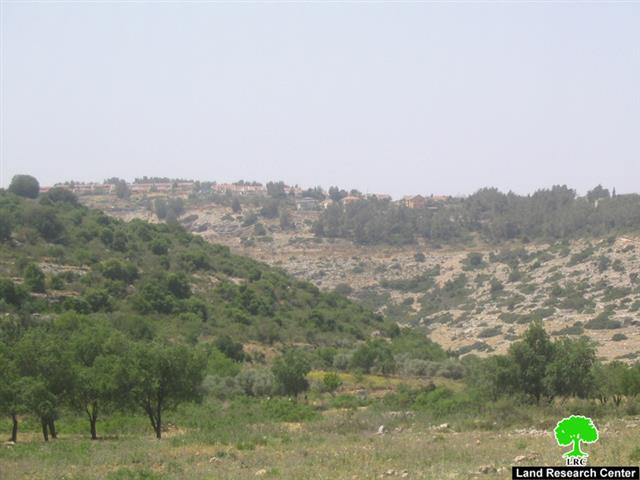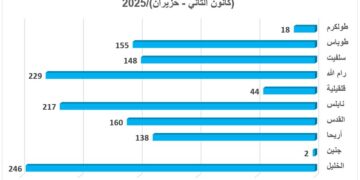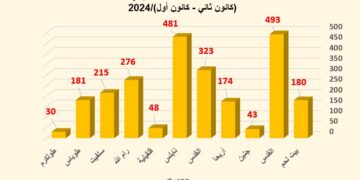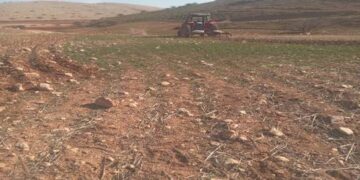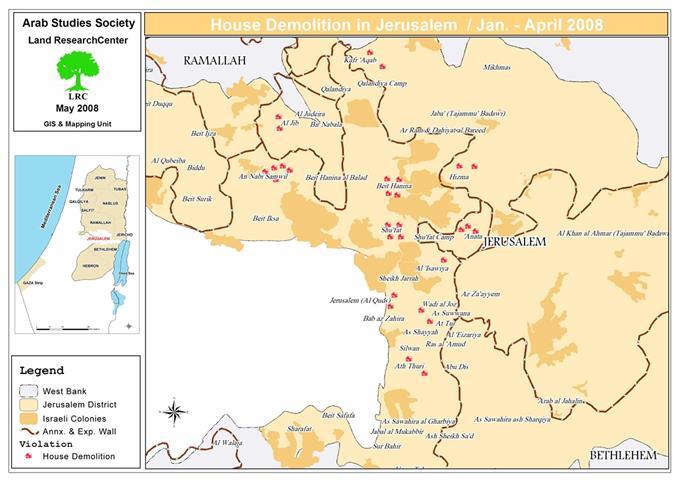The Israeli settlers escalated their attacks and harassments against Palestinian farmers in the West Bank. On April 19th, 2008 , a group of Israeli settlers from Karni Shomron settlement located east of Qalqilyiah city uprooted 300 trees, about one-year that were planted in the lands of Mr. Hasan Mansour Wadi Qana village, north of the aforementioned settlement.
Karni Shomron is located about 350 meters away from Mr. Mansour’s land. A 4-kilometer agricultural road connecting the settlement of Karni Shomron with Wadi Qana passes close to Mansour’s land which made it an easy target by Israeli settlers.
Photo 1: Some of the olive trees uprooted by the settlers from Mr. Hasan Mansour’s land in Wadi Qana.
Celebrating the 'Pesah' Feast on the 22ed of April 2008, settlers of Karne Shomron settlement marched through Palestinian lands, uprooted trees and took other provocative actions by swimming into water springs located close to the targeted land and prevented land owner from accessing the land later on.
Photo 3: The settlers polluting the waters of Wadi Qana.
Hajj Hasan Mustafa Mansour Mansour was born in Wadi Qana in 1946. ever since the settlement was established in 1978, he has been witnessing the daily harassments by Israeli settlers living in the settlement. In early 2008, Mr. Mansour rented a 15-dunums piece of land in Al Mayadeen region of Wadi Qana for agricultural purposes. In February 2008, Mr. Hasan bought 200 olive trees and planted them in the land which, according to Israeli Settlers, was considered as an act of defiance against their control over the land.
It is worth noting that lands surrounding the settlements of Karne Shomron, Gnnot Shomron and Neve Oramin located to the north of Wadi Qana village have become vacant and underworked due to the frequent attacks by Israeli settlers against Palestinians working in their lands in an effort to annex the lands to the settlements. The land rehabilitation carried out by Mr. Mansour has encouraged other farmers to work on their lands, thus establishing a presence there.
However, on April 18th, 2008 Israeli settlers uprooted all of the newly-planted olive trees in addition to uprooting the branches of the remaining trees. Hajj Mansour, as a result, filed an official complaint against Israeli settlers' actions in Beit El.
Hajj Mansour spoke with of Land Research Center’s field workers and indicated the following: 'This is not the first time that my land’s been attacked and vandalized by the settlers; in 1999 a group of settlers uprooted 300 trees from my land and broke all of the vines of the trees that they could not uproot. When I called upon the Israeli DCL, they came into the site of the violation but did absolutely nothing. I saw some of the broken vines at the entrance of the settlement of Karni Shomron. When I pointed that out to the DCL Officer he made fun of me and informed that he does not want to bother the settlers at that point in time due to the upcoming Israeli elections.'
Settler aggression in Wadi Qana is not a new as reports about previous provocative actions by Israeli settlers were recorded since the Israeli occupation of the West Bank (including East Jerusalem) and the Gaza Strip in 1967. However, the frequency of such attacks has dramatically increased since the establishment of 7 settlements on the lands of Wadi Qana village; from the north, the settlements of Karni Shomron, Ginot Shamron and Neve Oramin were established; and from the south, the settlements of Nofiem and Yakir. The settlement of Ma’ale Shomron is located north of Wadi Qana while the settlement of Immanuel stands east of the vilage. The water sewage from this settlement has led to the pollution of Al Jouza and Al Fawwar springs as well as the Al Jammal and Al Bassa water pools. The presence of the afore-mentioned settlements constitutes a danger to the Palestinian life in the village as Palestinians are leaving it due to the systematic and consistent transfer policies adopted by Israeli settlers and Israeli occupation forces.
The settlement of Karni Shomron dumps its water sewage straight into the Wadi leading to the contamination of Ein Al Tannour spring thus making it unsuitable for human, animal and plant consumption. Moreover, the settlement of Neve Oramin (located in the middle of the Wadi) also dumps its water sewage into the Wadi causing more pollution to water resources. The following table lists the name of the settlements in the Wadi as well its relevant information:
|
No. |
Settlement |
Est. Date |
Building Area |
Total Area |
No. of Settlers until 2004 |
|
1 |
Karni Shomron |
1978 |
1351 |
7339 |
6,170 |
|
2 |
Ma’ale Shomron |
1980 |
216 |
1903 |
549 |
|
3 |
Yakir |
1981 |
342 |
1364 |
960 |
|
4 |
Amano’eil |
1982 |
328 |
1909 |
2585 |
|
5 |
Jniat Shamron |
1985 |
484 |
N/A |
N/A |
|
6 |
Nofiem |
1989 |
248 |
331 |
414 |
|
7 |
Nof Oranim |
1991 |
153 |
N/A |
N/A |
|
TOTAL |
3122 |
1746 |
10,678 |
||
In addition to what was previously stated, the continuous settlers harassments against Palestinians in the village has negatively impacted the agricultural sector in the Wadi; the area of the planted lands has dropped from 10,000 dunums to about 5,500 dunums as Wadi Qana lost more than half of its agricultural lands for the construction of the aforementioned Israeli settlements. Moreover, lands located in the close vicinity of the settlements have become useless due to the inability of Palestinians to access the lands as a direct result of settlers' pestering and attacks on farmers.
Tactics used by Israeli settlers in attacking Palestinian farmers vary; they included freeing large number of wild pigs towards Palestinian lands and forming settlers’ in groups to attack Palestinian farmers and herders and steal their sheep. The so-called “Environment Police” had also played a role in pressuring Palestinians in Wadi Qana as it prevented farmers from placing barbed wires around the borders of their lands to protect their harvest under the pretext that barbed wires would cause harm to wild animals in the region. See Map 1
::::::::::____
[1] http://en.wikipedia.org/wiki/Passover
Prepared by:
The Land Research Center
LRC


